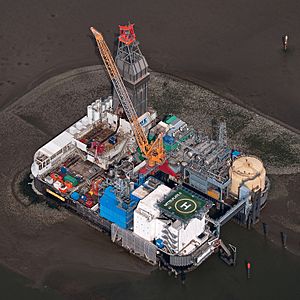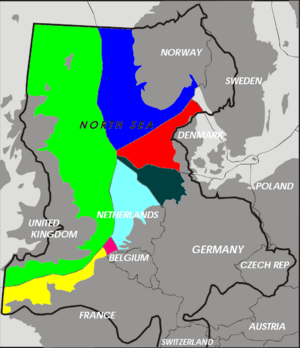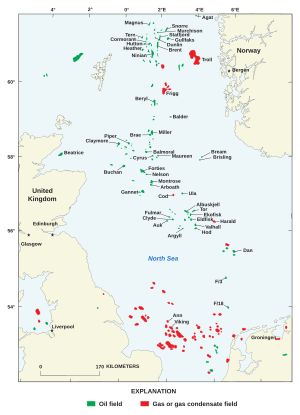North Sea oil facts for kids

North Sea oil is a mix of oil and natural gas found deep under the North Sea. These valuable energy sources are taken from underground rock layers called petroleum reservoirs.
When people in the oil business talk about the "North Sea," they often include nearby areas. This can mean the Norwegian Sea or the "West of Shetland" area, which isn't actually part of the North Sea itself.
A type of oil called Brent crude is still used today as a way to set oil prices around the world. It's like a standard measure for how much oil is worth.
Since oil production started in the 1960s, a huge amount of oil and gas has been taken from the North Sea. Experts believe there's still a lot left, possibly enough for many more years of production. This means the North Sea will likely stay an important place for getting oil and gas for a while.
Contents
How North Sea Oil Was Discovered
Early Discoveries (1851–1963)
People started getting oil from areas near the North Sea a long time ago. In 1851, a Scottish chemist named James Young extracted oil from a type of rock called oil shale. Around the same time, oil was found in Germany in 1859.
Later, in 1910, gas was accidentally found in a water well near Hamburg, Germany. In England, gas was discovered in 1938, and then oil was found in 1939. These early finds helped increase oil production in the area.
The Netherlands also found oil in 1943 in a village called Schoonebeek. They found their first gas in 1948. A very important discovery happened in 1959 when a huge gas field, now known as the Groningen gas field, was found. This field is one of the biggest gas fields in the world.
Modern Era of Oil and Gas (1964–Present)
Things really picked up in 1964 when the UK passed a law about exploring for oil and gas in its part of the North Sea. The first gas was found in the West Sole Field in 1965. Sadly, the drilling rig, called the Sea Gem, sank shortly after, and 13 people lost their lives. This showed how dangerous working offshore could be.
In 1969, a major oil discovery changed everything. Phillips Petroleum found oil in the Ekofisk field in Norway. This led to many more huge oil fields being found, like the Forties Oil Field in 1970 and the Brent oilfield in 1971. These discoveries made the North Sea a very important place for oil production.
After the world oil prices went up a lot in the 1970s, it became more profitable to drill for oil offshore. Oil production officially began in the North Sea in 1975.
The North Sea is known for its rough weather, which makes drilling very difficult and costly. Companies had to invent new technologies to make drilling safe and efficient. This included advanced ways to find oil and gas, like using 3-D and 4-D seismic imaging to see what's underground.
Many more oil and gas fields were discovered in the 1970s and 1980s, including Gullfaks, Snorre, Oseberg, and Troll. One of the biggest UK fields found recently was Buzzard in 2001. In Norway, the Johan Sverdrup oil field, discovered in 2010, is one of the largest finds on the Norwegian Continental Shelf. Production from Johan Sverdrup started in 2019.
The North Sea is one of the busiest places for offshore drilling in the world. Because of the long distances and harsh weather, it uses the largest fleet of special helicopters to transport workers. Aberdeen Airport in Scotland is the busiest airport for these helicopter flights, carrying half a million passengers each year.
Who Owns What: Licensing the North Sea

After a big meeting in 1958, countries around the North Sea agreed on how to divide the sea's resources. They drew lines to create "exclusive economic zones" (EEZs). These are areas where each country has special rights to explore and use natural resources.
Five countries are involved in North Sea oil production:
- Norway: The Norwegian Petroleum Directorate gives out licenses. Their areas are divided into large blocks.
- United Kingdom: The Oil and Gas Authority manages licenses. The UK's part of the North Sea is divided into smaller blocks. The government holds regular "licensing rounds" where companies can bid for the right to explore.
- Denmark: The Danish Energy Agency handles their sector, also divided into blocks.
- Germany: Germany shares a system of dividing blocks with the Netherlands.
- Netherlands: The Dutch sector is mainly for gas and uses the same block system as Germany.
Each country has its own rules for how companies can get permission to drill for oil and gas.
Oil and Gas Amounts: Reserves and Production
Most of the big oil reserves in the North Sea are in the Norwegian and British parts. Norway's sector alone is thought to hold more than half of the sea's oil and almost half of its gas.
More than half of the oil and gas that was originally in the North Sea has already been taken out. Both Norway and the UK keep track of how much oil and gas is left.
In 1999, the UK's oil production from the North Sea was at its highest, producing about 6 million barrels of oil per day. However, by 2010, this amount had dropped by half. Production has continued to decline since then. This means the UK now has to import more oil from other countries.
Gas production also peaked around 2001 and has gone down a lot since then. This means the UK also imports much more gas than it used to. Norway's oil production has also decreased significantly since its peak in 2001.
Storing Carbon Dioxide Underground
To help fight climate change, Norway has a special project in the North Sea. At the Sleipner gas platform, they clean the natural gas by removing carbon dioxide (CO2). Instead of releasing this CO2 into the air, they pump it deep underground into rock formations. This process is called carbon sequestration.
The Sleipner project stops about one million tonnes of carbon dioxide from going into the atmosphere each year. This is a small part of global emissions, but it shows how technology can help reduce pollution from oil and gas production. The cost of storing the CO2 underground is small compared to the overall cost of running the platform.


